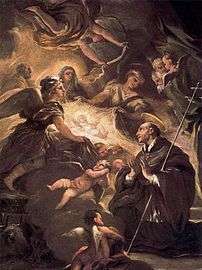Lawrence Giustiniani
| St. Lawrence Giustiniani, C.R.S.A. | |
|---|---|
|
St. Lawrence Giustiniani, San Rocco, Venice | |
| Patriarch; Archbishop; Confessor | |
| Born |
July 1, 1381[1] Venice, Republic of Venice |
| Died |
January 8, 1456 (aged 74) Venice, Republic of Venice |
| Venerated in |
Catholic Church (Canons Regular of St. Augustine) |
| Beatified | 1524, Rome, Papal States by Pope Clement VII |
| Canonized | 16 October 1690, Rome, Papal States by Pope Alexander VIII |
| Major shrine |
Basilica of San Pietro di Castello Castello, Venice, Italy |
| Feast |
|
| Attributes |
|
| Patronage | Patriarchy of Venice |
Lawrence Justinian, C.R.S.A. (Italian: Lorenzo Giustiniani, 1 July 1381 – 8 January 1456), is venerated as a saint by the Catholic Church. He was a canon regular who was appointed as a bishop and became the first Patriarch of Venice.
Biography
Giustiniani was a member of the well-known Giustiniani family, which includes several saints. The piety of his mother seems to have served as an inspiration for his own spirituality, as he chose of a life of prayer and service. In 1404, after he had been ordained a deacon, at the suggestion of an uncle who was a priest, he joined a community of secular canons following a monastic form of life on the island of San Giorgio in Alga.<ref name=SB /[2] He was admired by his fellows for his poverty, mortification, and fervency of prayer. Two years after his ordination to the Catholic priesthood in 1407, the community accepted the Rule of St. Augustine. He was chosen to be the first prior of the community.[3]
Gustiniani promoted the Constitutions which he been established for the canons of St. George, which was embraced by other communities of canons in the region and shortly thereafter he became the Prior General of a congregation. He was so zealous in spreading it that he was looked upon as if he were the actual founder of the Order.
In 1433, Pope Eugene IV, one of the founders of the Monastery of San Giorgio,[4] named Gustiniani as the Bishop of Castello. He found a diocese in shambles and his administration was marked by considerable growth and reform. In 1451, Pope Nicholas V united the Diocese of Castello with the Patriarchate of Grado, and the seat of the patriarchate was moved to Venice, making Giustiniani the first Patriarch of Venice, a post that he held for over four years.
It was during Gustiniani's rule that Constantinople fell to Muslim forces. Due to their centuries of close trading partnerships with Byzantine Empire, the people of Venice were in panic as to their future. He took a leading role in helping the Republic to deal with the crisis, working with the Senate to help chart its future, as well as with the clergy and people to calm them.[5]
Veneration
 St. Lawrence Giustiniani adoring the Baby Jesus, by Luca Giordano, (17th century).
St. Lawrence Giustiniani adoring the Baby Jesus, by Luca Giordano, (17th century). Lorenzo Giustiniani. 1465. Gallerie dell'Accademia, Venice, by Gentile Bellini
Lorenzo Giustiniani. 1465. Gallerie dell'Accademia, Venice, by Gentile Bellini De disciplina et perfectione monastica conversationis
De disciplina et perfectione monastica conversationis
He died on January 8, 1456, and was canonized by Pope Alexander VIII (1689–1691). His works, consisting of sermons, letters and ascetic treatises, have been frequently reprinted.
Pope Innocent XII (1691–1700) inserted his feast day in the General Roman Calendar for celebration on 5 September, the anniversary of his elevation to the episcopate. Because of the saint's limited importance worldwide, his liturgical celebration is no longer included in the General Roman Calendar,[6] and his feast was moved to 8 January, the day of his death.[7]
See also
References
- ↑ Saint of the Day, September 5 saintpatrickdc.org. Retrieved 2012-02-29.
- ↑ "San Lorenzo Giustiniani". Santi e beati (in Italian). Retrieved 19 January 2013.
- ↑ "Saints of the Canons Regular". Confederation of Canons Regular of St. Augustine. Retrieved 19 January 2013.
- ↑ "Congregations and Houses". Augustinian canons. Retrieved 16 February 2013.
- ↑
- ↑ Calendarium Romanum, Libreria Editrice Vaticana (1969), p. 137
- ↑ Martyrologium Romanum, Libreria Editrice Vaticana (2001), ISBN 88-209-7210-7
External links
![]() This article incorporates text from a publication now in the public domain: Herbermann, Charles, ed. (1913). "article name needed". Catholic Encyclopedia. New York: Robert Appleton.
This article incorporates text from a publication now in the public domain: Herbermann, Charles, ed. (1913). "article name needed". Catholic Encyclopedia. New York: Robert Appleton.
_-_Statue_of_Saint_Lawrence_Giustiniani.jpg)